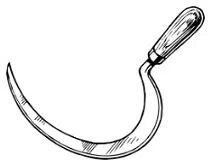A tool used to reap (cut grass or corn) is called a sickle . The sickle has a wooden handle and a curved blade with a sharp edge in the concave sector or with cutting teeth.
 Also called a mower , the sickle is usually used to cut the stems of grass plants . This instrument is similar to the scythe , although its blade is smaller and has a greater curvature: in this way, it is possible to handle the sickle with one hand and use the other to take the cut.
Also called a mower , the sickle is usually used to cut the stems of grass plants . This instrument is similar to the scythe , although its blade is smaller and has a greater curvature: in this way, it is possible to handle the sickle with one hand and use the other to take the cut.
The origins of the sickle date back to Prehistory : back then they were made of bone or stone. For a long time, the sickle was a key element in agricultural activity , although the development of mechanical harvesters caused it to lose preponderance. Sickles, on the other hand, were also used as weapons in the Middle Ages .
Due to its relevance in agriculture , the sickle became a symbol of work . The communist parties , in this framework, use a hammer and sickle as their banner, representing the union of peasants and the industrial proletariat. The hammer and sickle, in fact, were part of the flag of the Union of Soviet Socialist Republics ( USSR ).
For geography , a sickle is a narrow valley with great depth or one created by a river between two mountains. The narrow valley that usually constitutes the bed of a river that flows between walls of considerable height is also known as a sickle.
In this sense, we can highlight, for example, the Hoz del Río Júcar, which is located in the Spanish province of Cuenca and which is one of the most significant enclaves of the place. It is the result of the erosion of water and wind, it has undeniable natural beauty and it must also be emphasized that historically it was used as a defensive element.
Talking about the term sickle leads us to make clear, first of all, that depending on its meaning, its etymological origin is different. Thus, if reference is made to the curved instrument that is used in the field to kill herbs, it is established that it emanates from the Latin “falx” which, in turn, comes from the verb “facere” which is synonymous with “to make.” .
On the contrary, if we speak of sickle to refer to a type of narrowness that can be found in a valley, in that case its origin is in the Latin noun “faux”, which can be translated as “throat”.
In the same way, we cannot ignore the fact that the term we are now dealing with is also used within the field of medicine. Specifically, we talk about what is known as the falx cerebri. Falx cerebri is also the name used to refer to a membrane that exists inside the aforementioned brain, which has a vertical position and is identified because it separates what is the left cerebral hemisphere from the right cerebral hemisphere.
If it is called a sickle it is because it has a curved shape.
Finally, several Spanish towns include the term sickle in their name . Among them are Hoz de Valdivielso , Hoz de Arriba and Hoz de Abajo .
